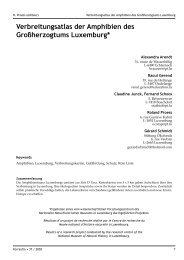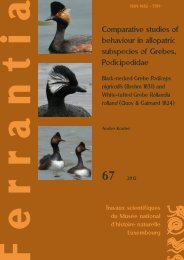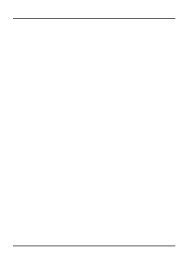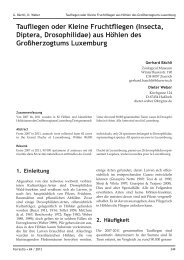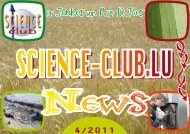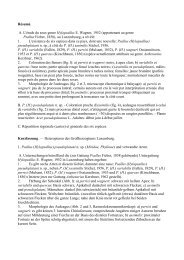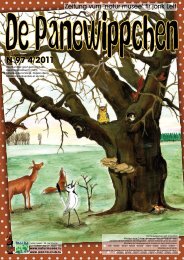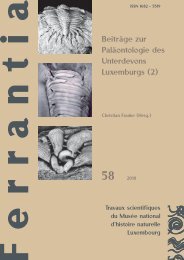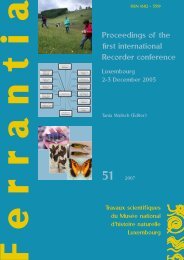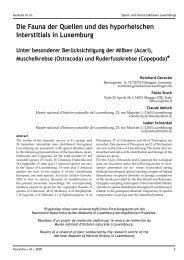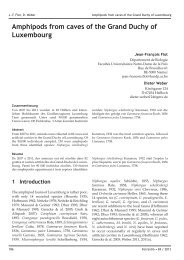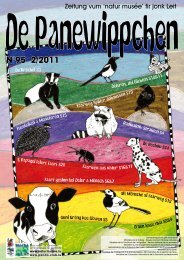Publi.complète - Musée national d'histoire naturelle
Publi.complète - Musée national d'histoire naturelle
Publi.complète - Musée national d'histoire naturelle
You also want an ePaper? Increase the reach of your titles
YUMPU automatically turns print PDFs into web optimized ePapers that Google loves.
Delsate, Steur, Schneider, Thuy Lower to Middle Emsian flora and fauna from Consthum and Merkholtz<br />
narrower. Many Devonian eurypterids were small<br />
to middle size animals (Pagea reaches 60 cm), although<br />
Lochkovian Pterygotus were still giant like<br />
the Silurian ones.<br />
Preserved positive material EIB147b in the continuation<br />
of this specimen adds some interesting<br />
details: 3 segments are longitudinally striated,<br />
forming many closely adjacent tubercles (strongly<br />
differing from the segment bosses of Willwerathia:<br />
see Anderson et al. 1998). A scorpionid aribution<br />
is discarded, because the distal scorpionid plates<br />
are much longer than wide (Geys 1991).<br />
Ferrantia • 36 / 2003<br />
EIB148 a & b<br />
A 30 mm plate ornamented by tubercles bears<br />
millimetric triangular « thorns » (three are well<br />
preserved) on the smoother distal part, and may<br />
be aributed to a pterygotid claw fragment.<br />
The counterpart EIB148b of this specimen provides<br />
further ornamentation details: triangular<br />
or lozenge shaped scales on the main part of the<br />
claw.<br />
Ostracoda Latreille, 1802<br />
Some plurimillimetric specimens seem aributable<br />
to Aparchitidae and Leperditellidae. Lippert<br />
1939 reported Leperditia klerfia Mauz, from the<br />
Clervaux Schists (E2) of Zweifelscheid (D).<br />
Vertebrata<br />
Subphylum Vertebrata Linnaeus, 1758<br />
Class Pteraspidomorphi Goodrich, 1909<br />
Subclass Heterostraci Lankester, 1868<br />
Order Pteraspidiformes Berg, 1937<br />
Family Psammosteidae Traquair, 1896<br />
Genus indet.<br />
EIB128 (Pl. 7, fig. 3 a,b)<br />
This 75 x 45 mm preserved plate bears eroded tubercles;<br />
it evokes a dorsal or ventral disk fragment<br />
of an “Agnatha” Heterostracan Psammosteidae,<br />
an identification that should be confirmed and<br />
precised by the detailed study of EIB128 by Del-<br />
sate & Blieck (work in progress).<br />
Discussion<br />
Among Psammosteiformes (sensu Benton 1993),<br />
Drepanaspididae and Guerichosteidae are known<br />
from the Emsian. This group is till now unknown<br />
in the Luxembourg and Belgium Lower Devonian,<br />
but the Psammosteiforme Drepanaspis exists<br />
in the Praguian-Emsian of Cornwall-Devon<br />
(UK) and the species Drepanaspis lipperti Gross<br />
is reported (orbital, branchial, cornual, ventral,<br />
dorsal, median and trunk plates, tail scales) from<br />
the Clervaux Schists (Klerfer Schichten, E2) of<br />
Zweifelscheid (Rhineland, D) near to the Grand<br />
Duchy of Luxembourg, by Lippert 1939, together<br />
with the placoderm Phlyctaenaspis sp (skull, spinal,<br />
postero-ventral, postero-lateral, antero-lateral<br />
and trunk plates) and Porolepis scales. It must be<br />
emphasised that Phlyctaenaspis is a synonym of<br />
Phlyctaenius, which is not considered a coccosteid<br />
anymore, and that the Phlyctaenaspis reported by<br />
Gross 1937 : 22-23 and Lippert 1939: 38 revealed<br />
to be an Arthrodire Actinolepina? skull internal<br />
mould (Blieck et al. 1998). Drepanaspis gemuendensis<br />
Schlüter is reported from the Lower Devonian<br />
of Gemünden in Hunsrück (see Bartels & Brassel,<br />
1990).<br />
It also bears some similarity with a ventral plate<br />
of Brachythoraci, possibly Migmatocephala (an<br />
alternative aribution would be a cranial plate of<br />
Brachythoraci Eubrachythoraci : Phlyctaeniina cfr<br />
Holonematidae ?). Antiarcha or Coccosteidae<br />
seem less probable (Coccosteus is not known in the<br />
Lower Devonian), but the Merkholtz discovery<br />
reminds the Asselberghs 1913 and Bordet 1939<br />
report of « Coccosteid plates » from the Schuttbourg<br />
Quartzophyllade at the Schubourg castle,<br />
bearing in mind that isolated bony plates of placoderm<br />
morphology found at the beginning of the<br />
last century were oen aributed to Coccosteus,<br />
which was referred to as a model.<br />
17



